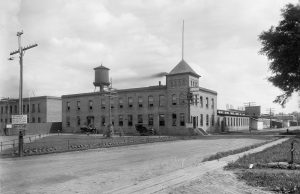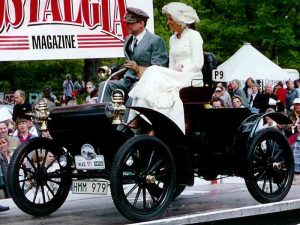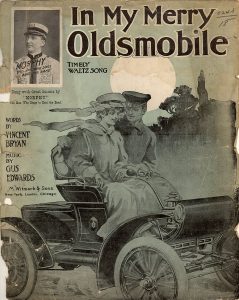
When Oldsmobile Was New
Ruby Scalera| August 2020 | Motorhead History
Thin wheel treads hedge the dirt roads leading to the ancient factory, that, from a distance, could as likely be an antiquated boarding school as a penitentiary. The two-story building, heightened only by one extra floor provided by the tower, hardly proclaims its automotive history, save for a stray carriage or two, more reminiscent of its years as a horse and buggy than of the future of motoring.
 But despite outward appearances, this innocuous factory scene is home to Old Motor Works, the second incarnation of Olds Motor Vehicle Company, founded on August 21, 1897, the earliest ancestor of the Oldsmobile. Ransom Eli Olds created the company in Lansing, Michigan, and two years later, in 1899, it would merge with Olds Gas Engine Works, and move to Detroit, and the simple factory scene, where it would go on to produce some of the most iconic cars ever to come from the American market.
But despite outward appearances, this innocuous factory scene is home to Old Motor Works, the second incarnation of Olds Motor Vehicle Company, founded on August 21, 1897, the earliest ancestor of the Oldsmobile. Ransom Eli Olds created the company in Lansing, Michigan, and two years later, in 1899, it would merge with Olds Gas Engine Works, and move to Detroit, and the simple factory scene, where it would go on to produce some of the most iconic cars ever to come from the American market.
In the early spring of 1901 Olds Motor Works had a whole line of automotive prototypes, including the famous Oldsmobile Curved Dash, ready for production. In 1901 they put out 425 models, earning it the title of first automotive manufacturer to produce gasoline-powered models in high volume. The Oldsmobile Curved Dash was the only prototype to see production, however, despite the company’s cache of production-ready prototypes. Worker error lead to a fire that burned the factory down to the ground, and the Curved Dash was wheeled out by two workers escaping the blaze, the only prototype to survive. A new factory was quickly erected, and Olds Motor Works set to work producing its sole design.
 Over the next three years, to 1904, the Oldsmobile Curved Dash was the first mass-produced car. It actually earned the title of first car made on an automotive assembly line, meaning it was built on an assembly line with interchangeable parts. It is a superlative often misattributed to Henry Ford, who produced the first cars on a moving assembly line at the Ford Motor Company.
Over the next three years, to 1904, the Oldsmobile Curved Dash was the first mass-produced car. It actually earned the title of first car made on an automotive assembly line, meaning it was built on an assembly line with interchangeable parts. It is a superlative often misattributed to Henry Ford, who produced the first cars on a moving assembly line at the Ford Motor Company.
The Oldsmobile, a nickname derived from Olds Automobiles and popularized in a 1905 song “In My Merry Oldsmobile”, could seat two passengers, and sold for $650, not inexpensive by the standard of the day, but $200 cheaper than the Ford Model C. It had a water-cooled single-cylinder engine, mounted in the center of the car, and managed to produced 5 horsepower, with a top speed of 20 miles per hour. It had two forward gears and one reverse gear and weighed just 850 pounds.
 The success of the 1901 production year would only grow. In 1902 Old Motor Works would produce 2,500 models, and by the end of its six-year run, in 1907, there would be a total production of 19,000 Oldsmobile Curved Dashes. In 1904 Ransom Olds would leave the company because of a dispute and would go on to build the REO Motor Car Company. Though production of the Oldsmobile Curved Dash would continue for three years to follow, Olds Motor Works felt the sting of their founder’s absence. In 1908 the company was swallowed up by GM, where it would go on to produce some of the most iconic cars in America today.
The success of the 1901 production year would only grow. In 1902 Old Motor Works would produce 2,500 models, and by the end of its six-year run, in 1907, there would be a total production of 19,000 Oldsmobile Curved Dashes. In 1904 Ransom Olds would leave the company because of a dispute and would go on to build the REO Motor Car Company. Though production of the Oldsmobile Curved Dash would continue for three years to follow, Olds Motor Works felt the sting of their founder’s absence. In 1908 the company was swallowed up by GM, where it would go on to produce some of the most iconic cars in America today.
Through a history of racing, high production, muscle cars and a legacy that extends even into the most current century, though it recently met its end, Oldsmobile remains a company with humble beginnings, the story of a small, single production manufacturer, who went on to change automotive history.

